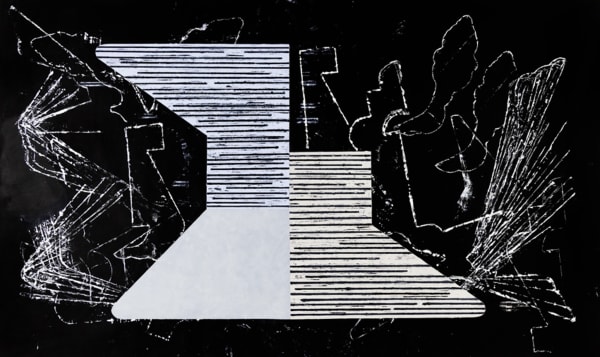PAULO WHITAKER: TEMAS PARA DISCUSSÕES INCONCLUSIVAS
Opening:
October 5, Thursday, from 19h to 22h
Exhibiting period:
October 5 - November 4, 2017
Visiting time:
Mondays to Fridays, from 10:30 to 19:00 / Saturdays, from 11:00 to 16:00
Losing it
Laura A. L. Wellen
There is weirdness and discomfort in these paintings. At least, this is what Paulo looks for when he makes them, what draws him back to abstraction, to the canvas, over and over. There is no narrative here, and so the task of the writer-- my task -- is made more difficult, less grounded in nouns and verbs, more in description and sensation. In some ways, these paintings themselves hang together like words in a sentence; indeed, Paulo insists on naming exhibitions rather than naming individual works, so together the fragments of thoughts lend themselves to a shared idea. And what are words, in the end, but abstractions strung together with an agreed upon connection to larger abstractions: to emotions, to experiences, to things that have happened, to histories. If we remove narrative, we describe impressions. The science behind emotions indicates that we perceive and pick up on the emotional states of others. That is, emotional fluctuations hang, quite literally, in the air.How do we talk about that intangible stuff, that stuff that permeates the air,that inexplicable sensation of dread or madness that creeps into our exchanges?
This text will be translated to Portuguese and will live in the space with the paintings, but far away from my own world, from the agreed-upon meanings of my own languages and spaces. Am I saying anything that will resonate in a different language, a different context? These are also abstractions that I write, though we use the term less often to describe a writer or curator's work. I have been reading descriptions of colors, to think about that material of abstraction and figuration, how we cathect to color. Describing blue, Rebecca Solnit writes, "The color of that distance is the color of an emotion, the color of solitude and of desire, the color of there seen from here, the color of where you are not. And the color of where you can never go".[i] Paulo tells me he watches the new version of Twin Peaks, and is drawn to the faraway background storyline."You don't get it," he writes, "but then you get it just to lose it again." It is like that blue deep in the horizon, always slipping through our fingers. Indeed, the effect is in the suggestion of atmosphere, not in narrative. It is in the tension, the desire, and the heaviness in the air. Paulo returns to works from the early 1990s, and he includes paintings that have large empty spaces in them, ambience and emptiness, tension and suggestion. What hangs in the air here, or, perhaps, then? This is not only a question about abstraction or about the materials of painting. Today they spray chemicals over the entire city where I live to kill the mosquitoes of the largest flood in U.S. history, the hurricane named Harvey. What fills the air where you live and how will it poison or protect you, how will it fill your days and haunt your restless nights?
Paulo's cobalt blue oval hanging over a sky-blue form on a black ground is that blue of distance for me, that unknowable blue that mystifies and suspends and is a far-awayness that Paulo and I have also as we talk about this text, about this exhibition I will not see, or will see only through photographs. "I am carried by something that I don't quite understand point by point," Paulo writes, "but have pleasure with the images, the strangeness, the weirdness... the details...the painterliness... how they present their thing to someone who is not at all interested in the story but interested in everything else." He is writing to me about television, but this is also about painting, and especially painting abstraction. Look at everything else, look at the strangeness, look at the details, at the paint-- that blue on that canvas, hanging in the space. Like the past, like abstraction, like the present, like our shared words across languages and places, like that distant blue you can just make out, you get it just to lose it again.
[1] Rebecca Solnit, "The Blue of Distance," in A Field Guide to Getting Lost (New York: Penguin, 2005): 29.
About the artist
Paul Whitaker was born in São Paulo in 1958. He graduated in Arts Education from the University for the Development of theState of Santa Catarina - UDESC / SC, in 1984. Attended as a resident artist atPlug In ICA (Winnipeg, Canada, 1991), the E-Werk Freiburg (Freiburg, Germany,1992) and the Banff Centre for the Arts (Banff, Canada, 1999). Lives and works in São Paulo.


